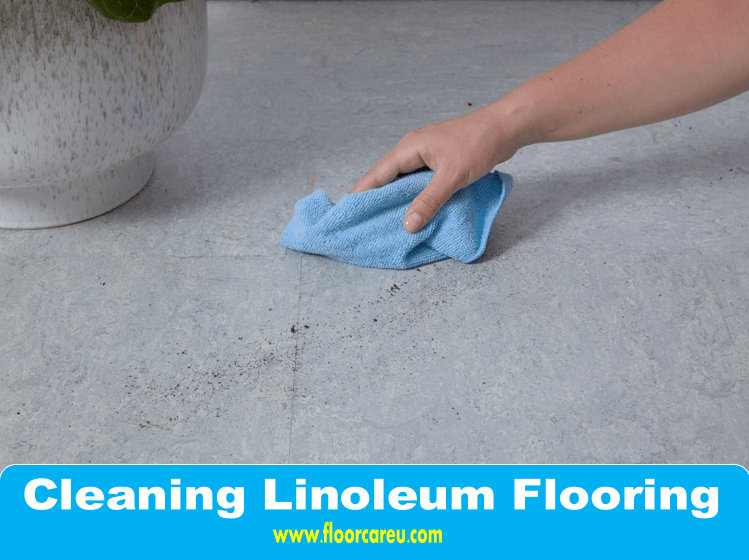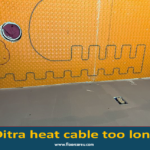Cleaning Linoleum Flooring: To clean linoleum flooring, using a mild dishwashing soap or neutral pH linoleum cleaner with a damp mop or cloth is best. Avoid using acidic or chemical-based cleaning products like bleach or ammonia, as linoleum is sensitive to them.
Instead, one gallon of hot water, one cup of white vinegar, and a few drops of dish soap can effectively clean and maintain the floor. It is important to wring excess water out of the mop while cleaning, as linoleum can trap water and cause damage.
Linoleum flooring is a popular choice for its durability and affordability. However, without proper care and maintenance, it can accumulate dirt and lose its shine. Regular cleaning of linoleum flooring keeps it looking good and extends its lifespan. This article provides tips on how to clean and care for linoleum flooring, including what cleaning products to avoid and the best cleaning solution for the floor. By following these tips, one can ensure that their linoleum flooring remains in top condition for years.
Pre-cleaning Preparation
Before cleaning your linoleum flooring, pre-clean by removing any loose dirt and debris. Use a broom or vacuum to thoroughly clean the surface before mopping with a mild cleaning solution. This step helps prevent scratching and ensures a more effective cleaning.
Gathering Cleaning Supplies
Before starting the cleaning process, gathering the necessary cleaning supplies is essential. Ensure you have the following items ready:
- Mild dishwashing soap
- White vinegar
- Lemon juice
- Mop
- Bucket
- Clean water
- Soft cloth or mop
Clearing The Floor Area
To prepare for cleaning, clearing the floor area of any obstacles and furniture is important. This step ensures that the entire linoleum surface is accessible for thorough cleaning. Clearing the floor area also prevents any hindrance during the cleaning process and allows for a more efficient and effective cleaning procedure. “`

Cleaning Process
For cleaning linoleum flooring, create a solution with one gallon of hot water, one cup of white vinegar, and a few drops of dish soap. Mop the floor with this effective mixture to remove dirt and maintain the linoleum’s finish without harsh chemicals.
Mopping With Vinegar Solution
To maintain the cleanliness of your linoleum flooring, mopping with a vinegar solution is highly effective. Mix one cup of white vinegar with every gallon of hot water. Add a few drops of dish soap to the solution. Dip the mop into the solution and wring out the excess water. Mop the floor thoroughly, focusing on areas that accumulate dirt and grime. This natural solution is safe for linoleum and leaves a clean, fresh scent behind.
Scrubbing Stubborn Stains
If stubborn stains are present, scrubbing can help remove them effectively. Create a paste using baking soda and water. Apply the paste to the stain and gently scrub with a soft brush or sponge. Rinse the area with clean water and dry it thoroughly. For tough stains, consider using a commercial linoleum cleaner that is safe for your flooring.
Drying The Floor
After cleaning the floor, it is vital to ensure it is completely dry. Use a clean cloth or towel to wipe the surface, especially in areas where water may have accumulated. Proper drying helps to prevent any water damage and keeps your linoleum flooring in excellent condition.
Removing Scuff Marks
Scuff marks can detract from the beauty of your linoleum flooring. However, with the right techniques, you can easily remove them and restore the floor’s appearance.
Using Baking Soda Paste
Baking soda is a versatile and effective cleaning agent. To remove scuff marks from linoleum flooring, create a paste by mixing baking soda with a small amount of water. Apply the paste to the scuff marks and gently scrub the affected areas with a soft cloth or sponge. The baking soda paste’s mild abrasive action helps lift and remove the scuff marks without damaging the linoleum surface.
Rubbing With a White Eraser
If the scuff marks persist, another effective method involves using a white eraser. Rub the scuff marks with the white eraser, applying gentle pressure. The eraser’s texture helps to lift the marks without damaging the linoleum surface. After rubbing, wipe the area with a damp cloth to remove eraser residue and reveal the restored floor beneath.
Restoring Linoleum Floors
Polishing and buffing are essential steps in restoring the luster of linoleum floors. Using a low-speed buffer equipped with a soft buffing pad, gently polish the surface in circular motions to remove any surface scratches and bring out the natural shine of the linoleum. This process helps to revive the original luster of the flooring, making it appear rejuvenated and vibrant.
After polishing, applying a high-quality linoleum floor finish is crucial to protect the surface and maintain its freshly restored appearance. Choose a water-based floor finish compatible with linoleum and apply it evenly using a clean microfiber mop. Allow the finish to dry completely before applying additional coats for enhanced durability and long-lasting protection.
Final Tips For Maintenance
Following a few simple tips can help preserve your linoleum flooring’s beauty and longevity. Here are some essential maintenance tips to keep your linoleum floors looking pristine.
Regular Cleaning Schedule
- Establish a regular cleaning routine to prevent dirt buildup.
- Sweep or vacuum the floor daily to remove debris and dust.
- Mop the floor weekly using hot water, white vinegar, and dish soap.
- Avoid using excessive water to prevent damage to the flooring.
Avoiding Harsh Chemicals
- Steer clear of harsh chemicals like bleach or ammonia-based cleaners.
- Opt for mild dish soap or neutral pH linoleum cleaners for gentle cleaning.
- Use a damp mop or cloth with the cleaning solution to protect the linoleum.
Frequently Asked Questions For Cleaning Linoleum Flooring
What Is The Best Thing To Clean Linoleum Floors With?
Clean linoleum floors with hot water, white vinegar, and a few drops of dish soap.
What Not To Use On Linoleum Floors?
Avoid using acidic or chemical-based cleaners like bleach or ammonia to clean linoleum floors, as they can damage the material. Instead, use a mild dishwashing soap or neutral pH linoleum cleaner with a damp mop or cloth. Additionally, never use ammonia-based cleaners on your linoleum floors.
A solution of one gallon of hot water, one cup of white vinegar, and a few drops of dish soap are effective for floor care. Remember to wring excess water out of your mop, as linoleum traps water, which can cause damage.
Can You Use Dawn To Clean Linoleum Floors?
Yes, Dawn can be used to clean linoleum floors. However, it is recommended to use a DIY solution of one gallon of hot water, one cup of white vinegar, and a few drops of dish soap for effective floor care.
Avoid using ammonia-based cleaners or acidic, chemical-based cleaning products like bleach on linoleum flooring. Always wring excess water out of the mop while cleaning to prevent water damage to the floor.
What Does Vinegar Do To Linoleum?
Vinegar mixed with hot water and lemon juice effectively removes dirt from linoleum without causing damage.
How To Clean Linoleum Floors Effectively?
For best results, use hot water, white vinegar, and a few drops of dish soap to clean linoleum floors effectively.
What Should You Avoid When Cleaning Linoleum Floors?
Avoid using acidic or chemical-based cleaners like bleach or ammonia on linoleum floors. Instead, opt for mild dish soap or neutral pH cleaners.
Conclusion
Maintaining linoleum flooring is vital for longevity. Regular cleaning with gentle solutions like vinegar is key. Avoid harsh chemicals to prevent damage. Following proper care tips, you can enjoy a beautiful and durable linoleum floor for years.


